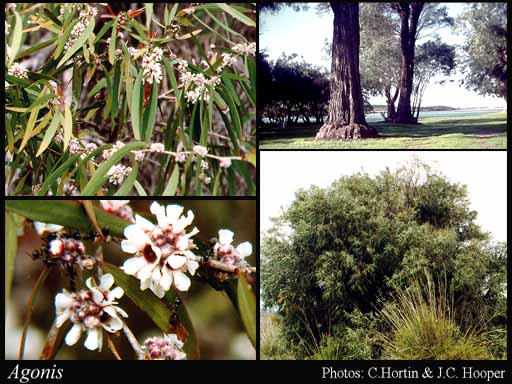- Reference
- Hort.Brit. [Sweet] Edn. 2:209 (1830)
- Name Status
- Current

Scientific Description
Common name. Peppermints. Family Myrtaceae.
Habit and leaf form. Shrubs, or trees (rarely); evergreen; bearing essential oils. Plants with neither basal nor terminal concentrations of leaves. Young stems with or without stem flanges. To 0.8–15 m high. Leptocaul. Mesophytic. Leaves minute to large; alternate (often crowded); ‘herbaceous’, or leathery; petiolate to sessile; gland-dotted; aromatic; edgewise to the stem, or with ‘normal’ orientation; simple; epulvinate. Leaf blades dorsiventral, or isobilateral, or centric; entire; flat, or solid; terete, or solid/angular; linear, or lanceolate, or oblong, or ovate; linear, or ovate, or obovate, or oblong, or elliptic; pinnately veined, or parallel-veined, or one-veined; cross-venulate, or without cross-venules. Leaves without stipules; without a persistent basal meristem. Stem anatomy. Secondary thickening developing from a conventional cambial ring.
Reproductive type, pollination. Fertile flowers hermaphrodite. Unisexual flowers absent. Plants hermaphrodite. Entomophilous, or ornithophilous. Pollination mechanism unspecialized.
Inflorescence and flower features. Flowers solitary (apparently, rarely), or aggregated in ‘inflorescences’; in heads. Inflorescences simple, or compound. The terminal inflorescence unit cymose. Inflorescences terminal, or axillary; usually a globular head, rarely 1-flowered; with involucral bracts, or without involucral bracts (when bracts inconspicuous); pseudanthial, or not pseudanthial. Flowers sessile; (bi) bracteolate; small to medium-sized; regular; cyclic. Free hypanthium present (petals ‘inserted on the calyx’); campanulate. Hypogynous disk present. Perianth with distinct calyx and corolla; 10; 2 -whorled; isomerous. Calyx present; 5; 1 -whorled; polysepalous; imbricate, or valvate. Sepals ovate, or triangular. Corolla present; 5; 1 -whorled; polypetalous; imbricate; regular; white, or pink (rarely); persistent. Petals limb orbicular; clawed. Androecial members definite in number, or indefinite in number. Androecium 10, or 15–30. Androecial members branched, or unbranched. Androecial sequence determinable, or not determinable. Androecial members free of the perianth; all equal; free of one another; when ‘definite’, 2 -whorled. Stamens 10, or 15–30; attached on the rim of the hypanthium; remaining included (not exceeding petals); diplostemonous to polystemonous; alternisepalous and oppositisepalous, or oppositisepalous; both opposite and alternating with the corolla members, or all alternating with the corolla members; erect in bud, or inflexed in bud. Filaments not geniculate. Anthers dorsifixed; versatile; dehiscing via longitudinal slits; introrse; cells parallel; tetrasporangiate; connective with a small globular gland. Gynoecium 3 carpelled. The pistil 3 celled. Gynoecium syncarpous; eu-syncarpous; inferior, or partly inferior. Ovary plurilocular; 3 locular. Epigynous disk present, or absent. Gynoecium stylate. Styles 1; from a depression at the top of the ovary; apical. Stigmas 1; capitate, or peltate. Placentation axile. Ovules 2–6 per locule; ascending; non-arillate; anatropous.
Fruit and seed features. Fruit non-fleshy (woody); dehiscent; a capsule (3-valved). Capsules septicidal, or loculicidal, or denticidal, or circumscissile. Fruit 3 celled. Seeds non-endospermic; winged, or wingless. Cotyledons 2.
Geography, cytology, number of species. Native of Australia. Endemic to Australia. Australian states and territories: Western Australia. South-West Botanical Province.
Etymology. From the Greek for "gathering or collection", probably referring to the small tight, globular flower-heads. An alternative, but less likely, derivation is from the Greek for "without" and "angle", referring to the calyx.